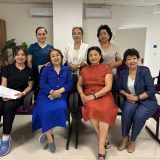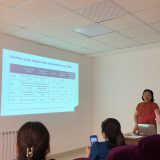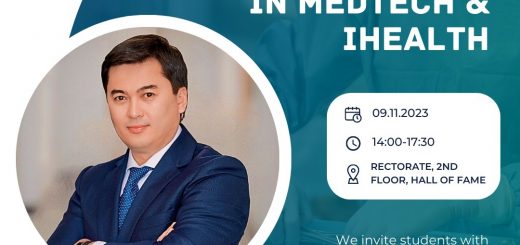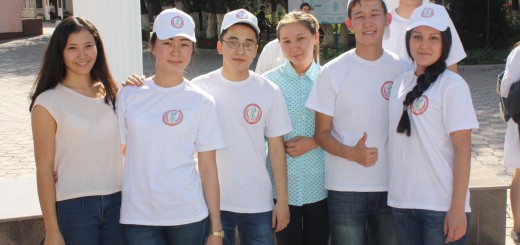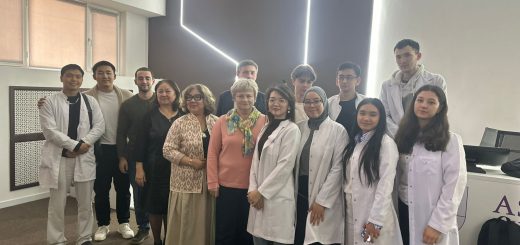Doctors Received Training on the Diagnosis of SMA and Monitoring of Adult Patients Using International Scales
The Department of Nervous Diseases of Asfendiyarov Kazakh National Medical University (KazNMU) continues its series of educational events for practical healthcare, dedicated to the 95th anniversary of Asfendiyarov KazNMU and the 90th anniversary of Professor S.K. Kaishybayev’s memory. On June 17, 2025, a master class was held in Aktau as part of the implementation of the cascade training method for practical healthcare specialists, in accordance with the Roadmap for Improving Adult Neurological Medical Care by the Ministry of Health of the Republic of Kazakhstan for 2025–2027 No. 03324 dated January 23, 2025. The event was supported by the “Association of Neurologists” of Kazakhstan, the Health Department of Mangystau Region, and the Mangystau Multidisciplinary Regional Hospital.
The master class was conducted by Professor G.A. Mukhambetova and Associate Professor R.B. Nurzhanova of the Department of Nervous Diseases at Asfendiyarov KazNMU. The training covered the main criteria for the diagnosis of spinal muscular atrophy (SMA), possibilities for comprehensive treatment, rehabilitation, and monitoring of adult SMA patients using international clinical scales — RULM (Revised Upper Limb Module), HFMSE (Hammersmith Functional Motor Scale Expanded), and 6MWT (6-Minute Walk Test). The educational program aimed to enhance the qualifications of physicians working with patients who have rare neurological disorders. Special attention was given to modern approaches for assessing motor functions, planning therapy, and monitoring treatment effectiveness.
The management of adult patients with spinal muscular atrophy (SMA) is becoming an increasingly relevant topic in modern neurological and multidisciplinary practice. This is due to several factors:
- Increased Life Expectancy: Thanks to advances in early diagnosis and the emergence of effective disease-modifying therapies (such as nusinersen, risdiplam, onasemnogene abeparvovec), patients with SMA, especially types I and II, are now more frequently reaching adulthood. This necessitates a shift in care delivery — from pediatric to adult services.
- Insufficient Preparedness of the Adult Healthcare System: Historically, SMA has been considered a pediatric condition, and many adult patients find themselves “outside the system” after transitioning from childhood care. The lack of structured pathways between pediatric and adult specialists often leads to gaps in follow-up, deterioration of condition, and loss of previously achieved progress.
- Specific Clinical Features in Adults: In adults with SMA, the disease course is characterized by slower progression but steady functional decline, with a predominance of orthopedic complications, respiratory dysfunction, and reduced endurance. There is also often a psycho-emotional burden related to social isolation and decreased quality of life.
- Need for a Systematic Monitoring Approach: Adequate monitoring of adult SMA patients requires:
- The use of validated international functional scales (RULM, HFMSE, 6MWT, etc.),
- Regular assessment of respiratory function, digestion, nutritional status, pain levels, and psychosocial adaptation,
- Involvement of a multidisciplinary team (neurologist, pulmonologist, orthopedist, nutritionist, psychologist, etc.).
- Access to Therapy and Equal Treatment Rights: Many adult patients still face barriers to therapy access due to age, disease stage, or insufficient physician awareness. However, adult patients have the full right to treatment and follow-up care, just like children.
- Social and Occupational Rehabilitation: Given the chronic nature of SMA, the management of adult patients must also address employment, education, accessibility, self-fulfillment, and mental health support, alongside medical care.
According to the participants, the master class was an important step in developing expert care for adult SMA patients in the country: “We not only mastered international techniques but also discussed the practical aspects of applying these scales in clinical practice. This will allow us to more accurately track disease dynamics and individually tailor treatment strategies.”
The acquired knowledge is planned to be implemented in the practice of specialized medical centers and used within a multidisciplinary approach to managing patients with SMA.




